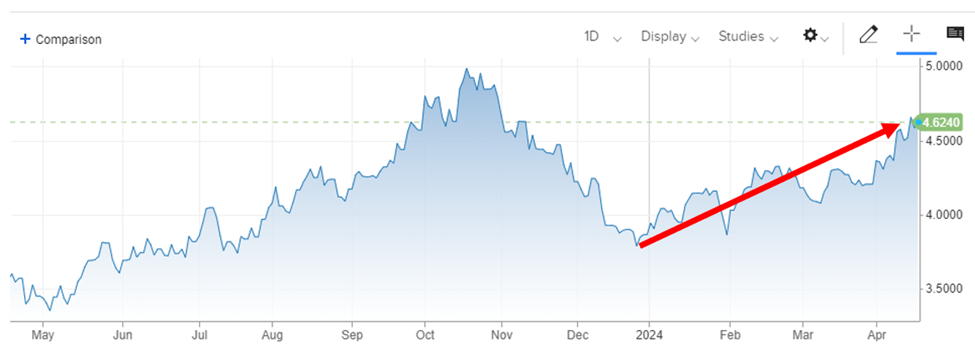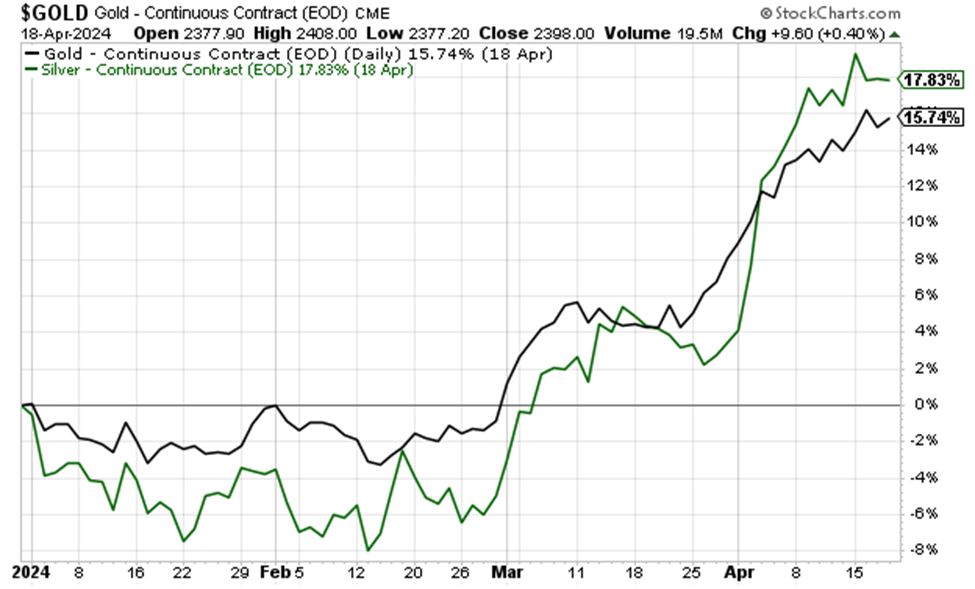A “targeted” counterattack last night… the 10-year Treasury yield is a problem for stocks… home sales fall thanks to expensive mortgages… silver might shine more than gold
It continues to be a busy news cycle. Let’s follow up yesterday’s headline-driven Digest with another tour through the top events impacting investor portfolios.
First up is last night’s Israeli counterattack on Iran.
A “limited strike” to avoid escalation
Overnight, Israel launched a targeted strike in the area around Isfahan in central Iran.
Let’s go straight to The Wall Street Journal:
Much remained unclear about the extent or the impact of the Israeli action. State-run news agency IRNA said Friday morning that its reporters hadn’t seen any large-scale damage or explosions anywhere in the country and that no incidents were reported at Iran’s nuclear facilities…
Iranian state television repeatedly played down the episode in its broadcasts, saying three small flying objects had been downed by air-defense systems and suggesting they had been launched from within the country.
With the limited information available Friday morning, it appears this was more of a theatrical operation. Israel felt obligated to respond after Iran’s attack last Saturday, yet it didn’t want to escalate the violence through a stronger display of force.
Back to the WSJ:
The narrow Israeli attack and Iran’s rhetoric in response appeared to be an attempt by both sides to calm tensions after more than a week of concerns that Israel’s war with Hamas in Gaza would metastasize into a bigger regional conflict, though fears remain of a miscalculation.
As I write, the markets are mixed in handling the news. While the Dow is up, the S&P and Nasdaq are selling off. We’ll keep you updated if/when more details emerge.
Meanwhile, the 10-year Treasury yield has entered “the danger zone”
So says Vanguard.
Let’s jump straight to Bloomberg:
The Treasury market is nearing levels that risk triggering a large selloff, pushing yields on 10-year bonds back to 5%, according to Vanguard.
“We are in a danger zone right now,” Ales Koutny, head of international rates at Vanguard, said in an interview. Even a small move higher — past the critical 4.75% level — could force investors to abandon their bets on a rally, giving way to a wave of selling that could push yields toward the highs of 2007, he said.
Let’s back up a moment to make sure we’re all on the same page.
A surging 10-year Treasury yield is bad news for most stocks. The higher this yield goes, the higher the discount rate used when analysts value a stock. Given the math involved, the higher the discount rate, the lower the net present value of a company’s future cash flows – which means lower stock prices.
As you can see below, the 10-year Treasury yield has been climbing all year (the red line). Earlier in the week, it briefly hit 4.69%. As I write, it sits at 4.62%, which is still uncomfortably close to the 4.75% level referenced by Vanguard.

The risk here is that the bond market is in danger of, effectively, a short squeeze of yields.
Investors loaded up on bonds late last year in anticipation of rate cuts by the Federal Reserve
Given that bond prices and yield are inversely correlated, that buying pressure pushed yields lower. The 10-year Treasury yield fell from nearly 5% in October to less than 3.8% in December.
But as you’re aware, the economic reports we’ve seen in 2024 are increasingly less supportive of multiple rate cuts.
The bond market has noticed this and has been repricing itself – pushing yields higher to better reflect the potential for “higher for longer” rates from the Fed.
But as the 10-year Treasury yield climbs, it inflicts pain on the investors who were betting on lower rates. At various points in recent weeks, to limit the mounting losses, some of these investors have sold their bonds.
Of course, this selling pressure pushes yields even higher, creating even greater losses for the remaining bondholders who are positioned for lower rates. Some of them must then sell to end the pain.
Rinse and repeat. This self-reinforcing dynamic squeezes yields higher.
Back to Bloomberg:
Many are being forced to sell off their holdings to limit losses, said Koutny, who helps manages Vanguard’s $1.7 trillion in active assets.
“We still think that there’s a residual long position left over,” Koutny said. “If that doesn’t manage to be orderly squared away, that disorderly move could be what takes us eventually to 5%.”
Barring something drastic in the Middle East, the direction of this 10-year Treasury yield will be the biggest driver of stock market direction over the coming days.
We’ll keep you updated.
Meanwhile, these climbing yields are throwing cold water on home sales
Yesterday, we learned from the National Association of Realtors that sales of previously owned homes dropped 4.3% in March.
This drop comes despite more homes hitting the market. Inventory climbed 4.7% month-to-month. It’s now up 14.4% compared with March of last year.
So, why are sales dropping even as more inventory becomes available?
Higher mortgage rates.
From CNBC:
Rising mortgage rates are likely the cause of the slowdown.
This sales count is based on closings from contracts likely signed in January and February. Mortgage rates stayed lower in January, in the mid 6%-range on the popular 30-year fixed loan. They then shot higher in February.
And though mortgages eased in March, they’ve surged again. U.S. News & World Report reports that today’s average 30-year fixed mortgage rate is 7.23%.
Home prices continue to rise alongside these climbing mortgage rates
It’s not just mortgage rates that are climbing.
The median price of an existing home sold in March was $393,500. That’s 4.8% higher compared to last year’s price. It’s also the highest price ever recorded for the month of March.
This combination of 7%+ mortgage rates and higher home prices continues to put homeownership out of reach for many Americans.
At the beginning of the month, Redfin published a report finding that prospective homebuyers must earn $113,520 a year to afford the typical house in the U.S. Yet, how much does the typical household bring in?
Just $84,072. Or about 25% less.
According to Chen Zhao, a senior economist at Redfin, “affordability has just totally collapsed.”
The hope is that the Fed will follow through with at least one interest rate cut later this year. Doing so should ease mortgage rates, though perhaps not by as much as hoped.
Given this, Zhao suggests would-be homebuyers should go ahead and pull the trigger today if possible:
If you’re ready and you can afford it, buy now. Conditions probably aren’t going to get significantly better.
[Though the combination of lower rates and boosted supply will help affordability] it’s not going to completely change the picture.
Meanwhile, if you like gold, you should love silver
While the bull market in gold is getting all the attention these days, don’t overlook silver.
As you can see below, the gains in silver (up 18%) are outpacing those of gold (up 16%) here in 2024.

When we compare silver mining stocks to gold mining stocks, the outperformance is even greater.
For example, a basket of gold mining stocks as represented by the VanEck Vectors Gold Miners ETF (GDX), is up 9%.
Meanwhile, the Global X Silver Miners ETF (SIL) is up 10%, but the returns of specific miners are what really catches the eye. Here are three examples:
- Seabridge Gold Inc. (SA) (also has heavy silver mining operations) – up 26% in 2024
- Endeavour Silver Corp. (EXK) – up 32% in 2024
- Coeur Mining Inc. (CDE) – up 37% in 2024
Better still, the gains for silver are likely to continue due to a growing supply shortage. From MarketWatch:
An annual report from the Silver Institute predicts that the global market for the metal is poised to mark a fourth straight yearly supply deficit.
The deficit would be driven in part by a rise in global industrial demand for silver to a fresh record high this year, according to the Silver Institute’s World Silver Survey, which is produced by researchers at Metals Focus and was released on Wednesday.
Silver demand for industrial applications rose by 11% to an all-time high of 654.4 million ounces in 2023, the survey said. That was supported by rising demand from “green economy applications,” including the solar industry, which uses the metal in photovoltaics, or the conversion of light into electricity.
Silver also has a valuation tailwind.
One way we measure this is by comparing its price to that of gold. This “gold/silver ratio” can help identify periods during which silver is historically cheap (or expensive) relative to gold.
This measurement is most useful to investors when it hits extremes. When the ratio climbs above about 80, it’s viewed as an indication that silver is relatively inexpensive relative to gold.
Here’s Forbes with what’s happened recently, and why it’s supportive of further outperformance from silver:
For precious metal investors the recovery of silver appears to validate a belief that gold and silver trade in harmony, generally close to a ratio of 78, with one ounce of gold being 78-times the price of silver.
Whenever the metals move away from that ratio, which has no scientific basis, they eventually return, a feature noticed over the past 10 years of metal trading.
Two months ago, the gold/silver ratio blew-out to 91 when the gold price was around $2037/oz and silver was stuck around $22.4/oz.
Silver’s rush to catch-up with gold and return to the 78-ratio started early last month with the combination of investor and industrial demand boosted by tight supply. The ratio currently stands at 83.6.
If history repeats itself, there’s more juice left in this silver trade.
Finally, speaking of “juice,” mark your calendar for next Tuesday at 10 a.m. Eastern
Love them or hate them, cryptocurrencies remain perhaps the best way for investors to get rich in the shortest period of time. Our crypto expert, Luke Lango, just put numbers on this:
Right now, thanks to the current rally in cryptos, there are over 1,500 new crypto millionaires being minted every single day…
Seriously, go look it up.
Over the last few months, in the lead-up to Bitcoin’s halving event, Luke has been searching for ways to take advantage of this millionaire-making corner of the market.
He believes he’s found it:
With the help from my team of world class programmers and data scientists, we’ve developed a powerful system that quickly scans the crypto markets looking for price breakouts.
And it’s already shattering our highest expectations.
In fact, this year my system could’ve tipped you off to cryptos that soared in 12 weeks or less.
• Like 1,362% from ArcBlock…
• 1,539% from Agoras…
• And 1,929% from Bonk.
Again, you could have made over 20X your money in under 12 weeks. This is the power of getting in front of cryptos before they surge in price.
Next Tuesday morning, Luke will be delving into all the details of this system. He’ll even be giving away the name of an altcoin that his system just flagged as likely to soar in the coming weeks.
Bottom line: If Bitcoin (and altcoins) follow their traditional post-halving price behavior, there’s a melt-up on the way with quadruple-digit return potential.
To join Luke next Tuesday, click here to reserve your seat for this free event.
We’ll keep you updated on all these stories here in the Digest.
Have a good evening,
Jeff Remsburg

